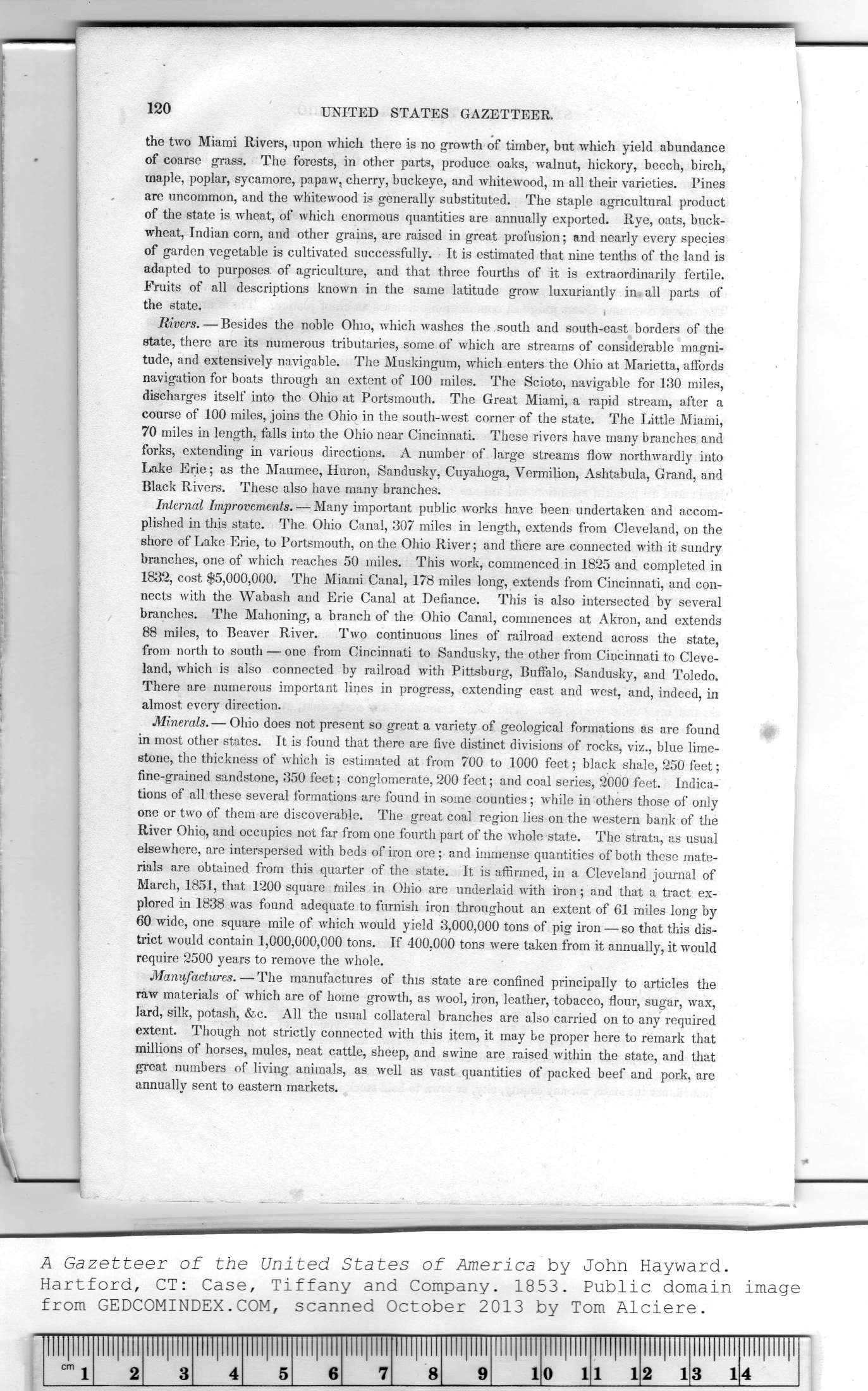|
|
Note: Ctrl and + increases the font size of the text below, Ctrl and - decreases it, and Ctrl and 0 resets it to default size.
120 UNITED STATES GAZETTEER.
the two Miami Rivers, upon which there is no growth of timber, but which yield abundance
of coarse grass. The forests, in other parts, produce oaks, walnut, hickory, beech, birch,
maple, poplar, sycamore, papaw, cherry, buckeye, and whitewood, m all their varieties. Pines
are uncommon, and the whitewood is generally substituted. The staple agricultural product
of the state is wheat, of which enormous quantities are annually exported. Rye, oats, buck-
wheat, Indian corn, and other grains, are raised in great profusion; and nearly every species
of garden vegetable is cultivated successfully. It is estimated that nine tenths of the land is
adapted to purposes, of agriculture, and that three fourths of it is extraordinarily fertile.
Fruits of all descriptions known in the same latitude grow luxuriantly in. all parts of
the state. ,
Rivers.—Besides the noble Ohio, which washes the . south and south-east borders of the
state, there are its numerous tributaries, some of which are streams of considerable magni-
tude, and extensively navigable. The Muskingum, which enters the Ohio at Marietta, affords
navigation for boats through an extent of 100 miles. The Scioto, navigable for 130 miles,
discharges itself into the Ohio at Portsmouth. The Great Miami, a rapid stream, after a
course of 100 miles, joins the Ohio in the south-west corner of the state. The Little Miami,
70 miles in length, falls into the Ohio near Cincinnati. These rivers have many branches and
forks, extending in various directions. A number of large streams flow northwardly into
Lake Erie; as the Maumee, Huron, Sandusky, Cuyahoga, Vermilion, Ashtabula, Grand, and
Black Rivers. These also have many branches.
Internal Improvements. — Many important public works have been undertaken and accom-
plished in this state. The Ohio Canal, 307 miles in length, extends from Cleveland, on the
shore of Lake Erie, to Portsmouth, on the Ohio River; and there are connected with it sundry
branches, one of which reaches 50 miles. This work, commenced in 1825 and completed in
1832, cost $5,000,000. The Miami Canal, 178 miles long, extends from Cincinnati, and con-
nects with the Wabash and Erie Canal at Defiance. This is also intersected by several
branches. The Mahoning, a branch of the Ohio Canal, commences at Akron, and extends
88 miles, to Beaver River. Two continuous lines of railroad extend across the state,
from north to south — one from Cincinnati to Sandusky, the other from Cincinnati to Cleve-
land, which is also connected by railroad with Pittsburg, Buffalo, Sandusky, and Toledo.
There are numerous important lines in progress, extending east and west, and, indeed, in
almost every direction.
Minerals.— Ohio does not present so great a variety of geological formations as are found
in most other states. It is found that there are five distinct divisions of rocks, viz., blue lime-
stone, the thickness of which is estimated at from 700 to 1000 feet; black shale, 250 feet;
fine-grained sandstone, 350 feet; conglomerate, 200 feet; and coal series, 2000 feet. Indica-
tions of all these several formations are found in some counties; while in others those of only
one or two of them are discoverable. The great coal region lies on the western bank of the
River Ohio, and occupies not far from one fourth part of the whole state. The strata, as usual
elsewhere, are interspersed with beds of iron ore; and immense quantities of both these mate-
rials are obtained from this quarter of the state. It is affirmed, in a Cleveland journal of
March, 1851, that 1200 square fniles in Ohio are underlaid with iron; and that a tract ex-
plored in 1838 was found adequate to furnish iron throughout an extent of 61 miles long by
60 wide, one square mile of which would yield 3,000,000 tons of pig iron — so that this dis-
trict would contain 1,000,000,000 tons. If 400.000 tons were taken from it annually, it would
require 2500 years to remove the whole.
Manufactures. — The manufactures of this state are confined principally to articles the
raw materials of which are of home growth, as wool, iron, leather, tobacco, flour, sugar, wax,
lard, silk, potash, &c. All the usual collateral branches are also carried on to any required
extent. Though not strictly connected with this item, it may be proper here to remark that
millions of horses, mules, neat cattle, sheep, and swine are raised within the state, and that
great numbers of living animals, as well as vast quantities of packed beef and pork, are
annually sent to eastern markets.
|
